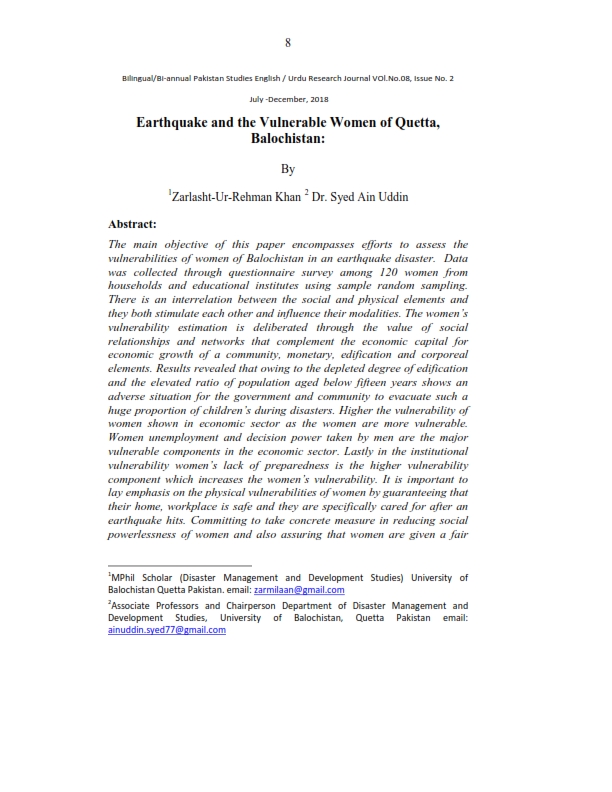Earthquake and the Vulnerable Women of Quetta, Balochistan
Keywords:
Vulnerability, Earthquake, Gender, Marginalization, RestrictionsAbstract
The main objective of this paper encompasses efforts to assess the
vulnerabilities of women of Balochistan in an earthquake disaster. Data
was collected through questionnaire survey among 120 women from
households and educational institutes using sample random sampling.
There is an interrelation between the social and physical elements and
they both stimulate each other and influence their modalities. The women’s
vulnerability estimation is deliberated through the value of social
relationships and networks that complement the economic capital for
economic growth of a community, monetary, edification and corporeal
elements. Results revealed that owing to the depleted degree of edification
and the elevated ratio of population aged below fifteen years shows an
adverse situation for the government and community to evacuate such a
huge proportion of children’s during disasters. Higher the vulnerability of
women shown in economic sector as the women are more vulnerable.
Women unemployment and decision power taken by men are the major
vulnerable components in the economic sector. Lastly in the institutional
vulnerability women’s lack of preparedness is the higher vulnerability
component which increases the women’s vulnerability. It is important to
lay emphasis on the physical vulnerabilities of women by guaranteeing that
their home, workplace is safe and they are specifically cared for after an
earthquake hits. Committing to take concrete measure in reducing social
powerlessness of women and also assuring that women are given a faircontribution and involvement in the disaster basic management fields but not over-burdening them with additional work.
References
ADPC, A. D. P. C.-. Understanding Vulnerabilities: II (Social, Cultural
and Economic). Capacity Building in Asia using Information
Technology Applications (CASITA).
B. Sungay, E. Cakti, & Erdik, M. (2012). Discussing Vulnerability,
Capacity And Resilience of The Community In The Face of
Earthquakes At A Microscale. Bogazici University, Kandilli
Observatory & Earthquake Research Institute.
Enarson, E. (2006). SWS Fact Sheet: Women and Disaster Natural
Hazard Mitigation Association.
Fordham, M. (2000). The Place of Gender in Earthquake Vulnerability
and Mitigation. Anglia Polytechnic University Disaster Studies
Project.
Hamilton, J. P., & Halvorson, S. (2007). The 2005 Kashmir Earthquake: A
Perspective on Women's Experiences. Geography Faculty
Publications, 27(4), 296–301.
Hewitt, K. (1997 ). Regions of Risk. Harlow, . Essex: Addison Wesley
Longman.
Izquierdo, E. (2015). A Gender Approach to Vulnerability and Natural
Disasters. CUNY Academic Works.
http://academicworks.cuny.edu/gc_etds/984.
Max Dilley. (2005). Natural Disaster Hotspots: A Global Risk Analysis.
World Bank.
Nesbitt-Ahmed, Z. (2017). Emergency cash transfers and women’s
economic empowerment in post-earthquake Nepal. IIED Working
Paper. IIED, London.
Shearer, P. M. (2009). Introduction to Seismology 2nd edition.
Wisner, B., Blaikie, P.M., Cannon, T., Davis, I. (2004). At Risk. Natural
Hazards, People's Vulnerability and Disasters, Routledge.
Women, U. (2015). New Gender Alert highlights the need to ensure
leadership roles for women in post-earthquake Nepal. Retrieved
from News: New Gender Alert highlights the need to ensure
leadership roles for women in post-earthquake Nepal - See more
at: http://www.unwomen.org/en/news/stories/2015/5/new-genderalert-on-nepal#sthash.sHsUwlCP.dpuf.
Yamane, T. (1967). Statistics, An Introductory Analysis New York:
Harper and Row, 2nd Ed.



